This unique Italian bread is one of our star recipes and everything you want in a crusty bread. Its golden crust, creamy texture and amazing flavor make it irresistible! It's perfect for toast, bruschetta and sandwiches. If you're not an experienced yeast baker, this post has step-by-step images and instructions to guide you.
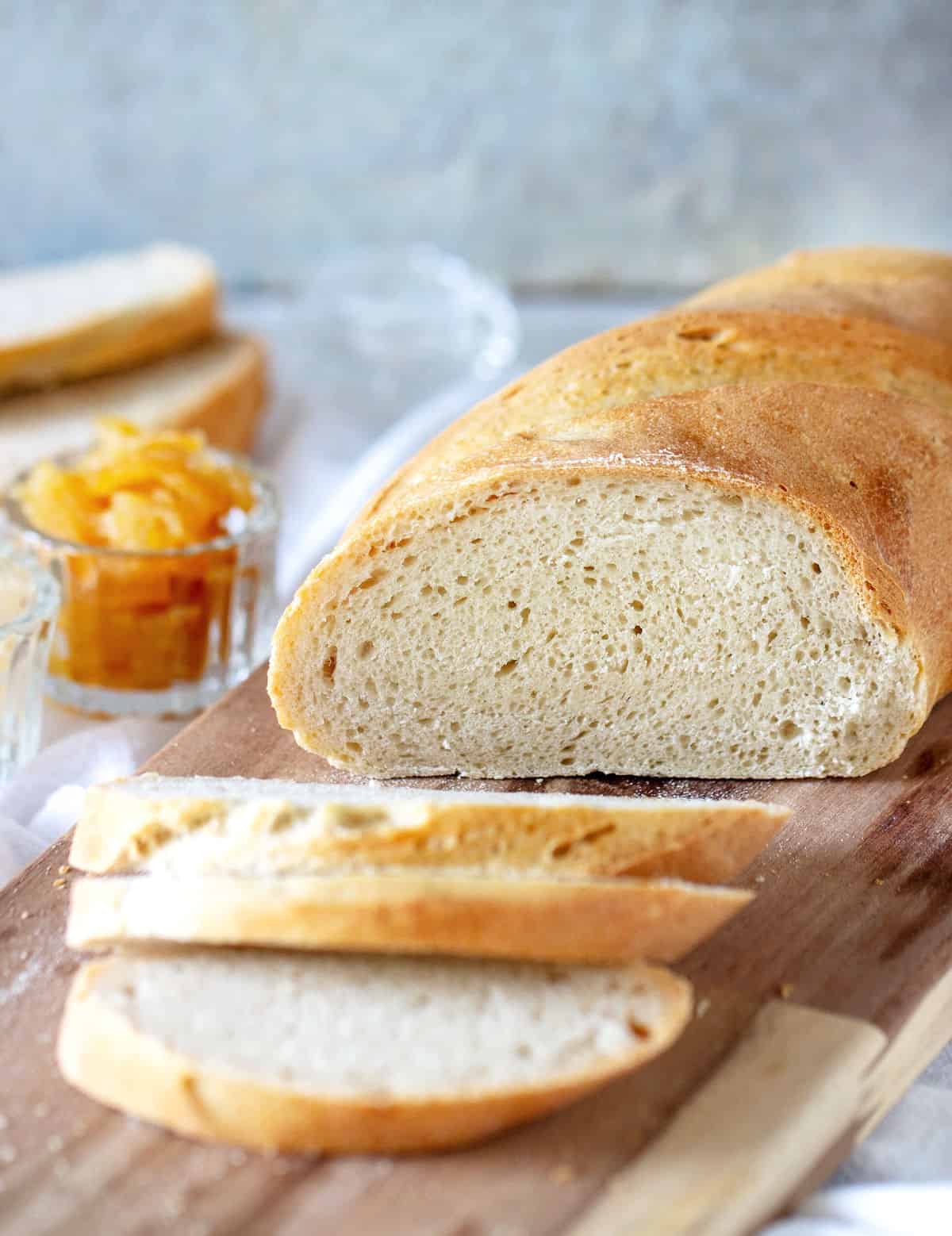
A golden loaf
I must admit this is one of my favorite breads I bake, especially for buttered breakfast toast and for sandwiches.
I love baking with yeast. And though I know it's not everybody's thing, some bread recipes are worth the time and dedication. This is one of them, for sure.
Others include oatmeal bread and 100% whole wheat bread. And let's not forget the easiest French bread, which requires no kneading and takes the complexity out of the bread-baking equation.
Semolina is a fine-textured flour made from durum wheat (used to make dried pasta). It has a nutty undertone and gives the bread a welcomed golden hue.
It's similar to very fine sand and different and much finer than bread flour.
Bread made with semolina has a crusty crust like no other.
FAQ
Semolina gives the bread a fantastic golden hue and a crusty exterior. Regular bread tends to have a lighter crumb.
This bread is a great appetizer to dip in olive oil or as part of an antipasto platter. It makes amazing toast and the best croutons, and is perfect for a quick bruschetta and some sandwiches.
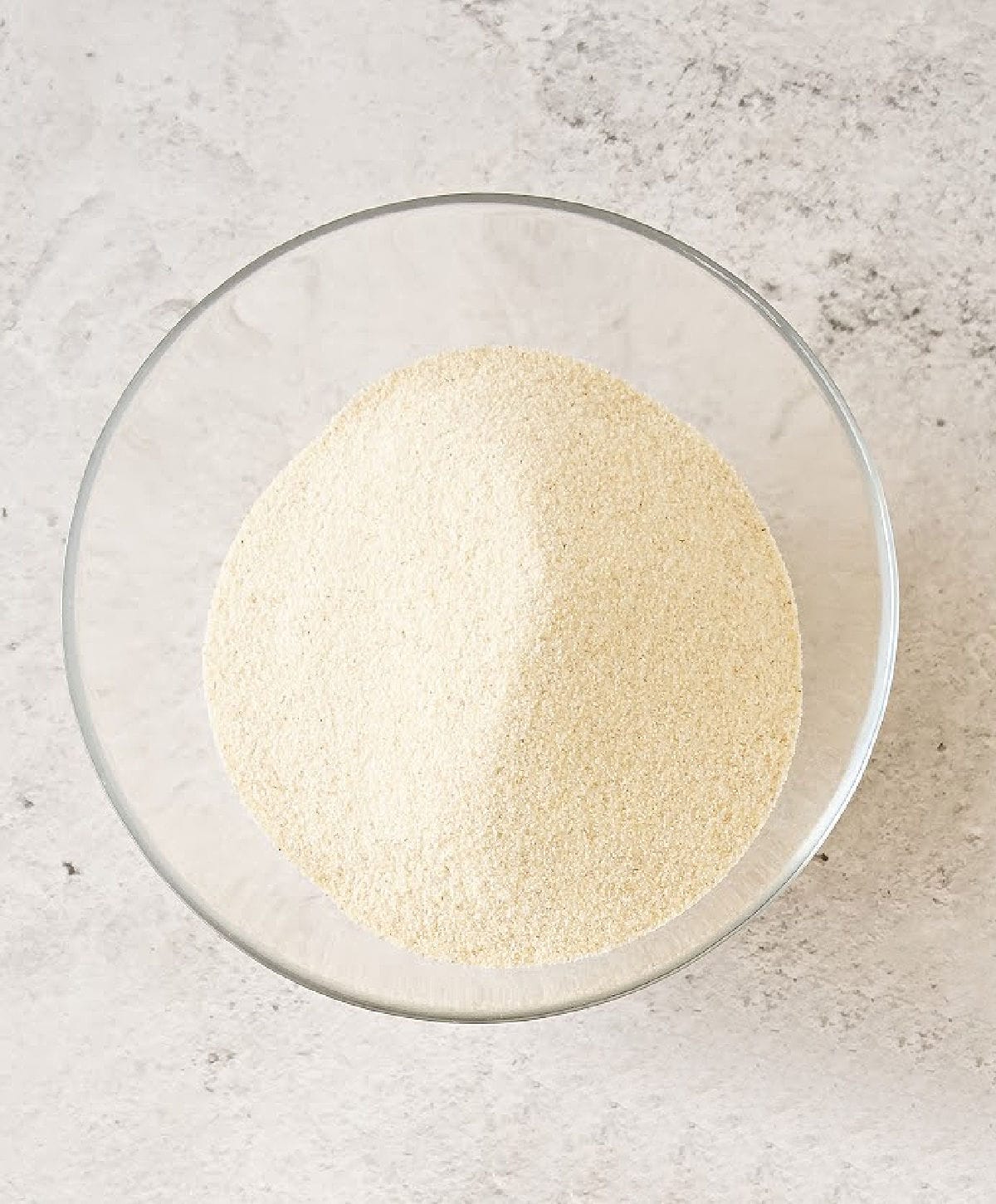
Tips for kneading bread dough
By hand
- Relax and get into a rhythm. I find it therapeutic.
- Use the base of your palms for effective kneading.
- Avoid adding too much flour; it can make the bread dense and dry. When you add extra flour (a small amount at a time), wait until you have kneaded for a minute or so before adjusting if necessary. Give the dough time to absorb the flour first.
- If the dough repeatedly sticks or if you're having trouble with a sticky dough, consider using a dough scraper to help fold and turn the dough.
With a stand mixer
- Use the dough hook attachment.
- Begin mixing the dough at a low speed. Once the ingredients are roughly combined, increase to a medium setting (often speed 2 or 3 on most mixers). Higher speeds can overwork the dough, leading to breads that are dense and heavy.
- Avoid over-kneading: most bread doughs, with some exceptions like brioche, need about 5-10 minutes of kneading in a stand mixer. You know the dough is well-kneaded when it is smooth and elastic.
- Do not overload your mixer. Check the capacity, as overloading can cause the motor to burn out. As a rule of thumb, if you're kneading dough for more than two loaves of bread, it might be better to divide the dough and knead in batches.
Steps to make semolina bread
This is a fantastic recipe because it's easy to knead by hand. It is even easier with a stand mixer (using the dough hook).
It is supple, soft, and not sticky.
Make the sponge
Active-dry yeast (image 1) is mixed with flour and water (images 2 and 3). After resting covered for 1 hour it will have grown, and air pockets like bubbles will have developed (image 4). If this doesn't happen, the yeast is not working. Don't go on. Go buy new yeast.
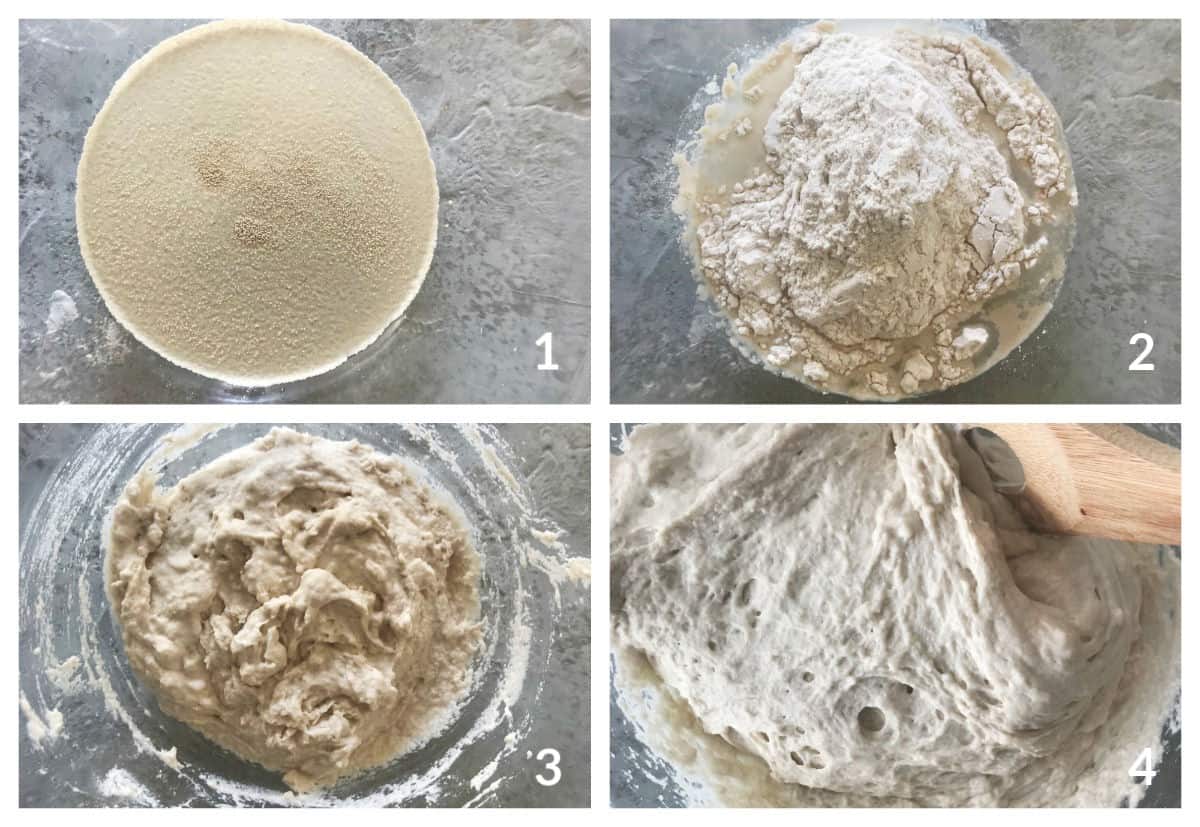
Adding the rest of the ingredients
- With the sponge ready, we need to add the rest of the ingredients (images 5 and 6).
- It will look like there are not enough wet ingredients when you turn it out onto the counter (image 7), but the dough starts forming in no time after you start bringing it together and kneading.
- After 1 or 2 minutes, the dough is rough but not sticky, and all the ingredients are combined (image 8).
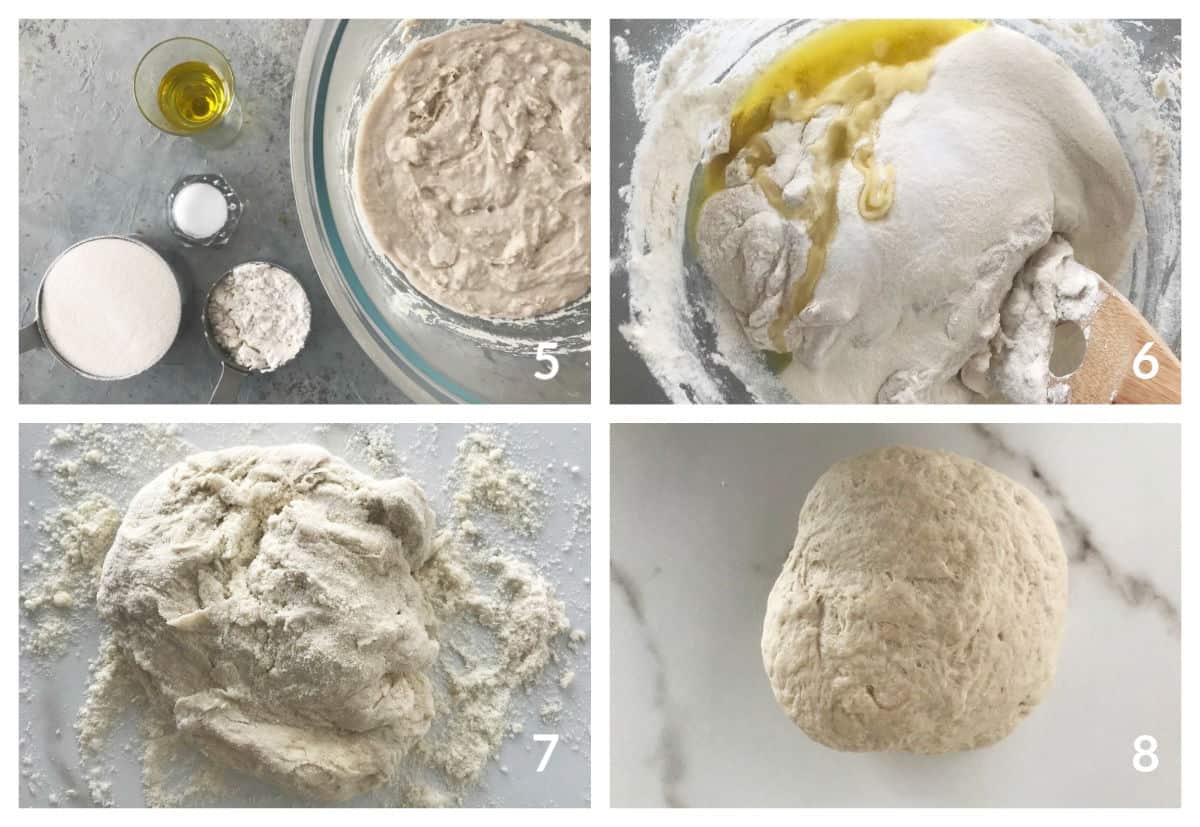
Kneading and proofing (rising) the dough
- How long does it take? About 7-8 minutes to knead it by hand and about 5 minutes with a stand mixer.
- Letting the dough rest and rise: this is a crucial part of bread making. Bread doughs with yeast need to rise until doubled in size in about 1 hour. So put it in an oiled bowl, turn it around so it's all greased, and cover the bowl with plastic (image below, left).
- Temperature: let rise in a draft-free, warm place. If the room is cold, I wrap it around something that keeps the temperature, like a sweater, blanket, or pashmina.
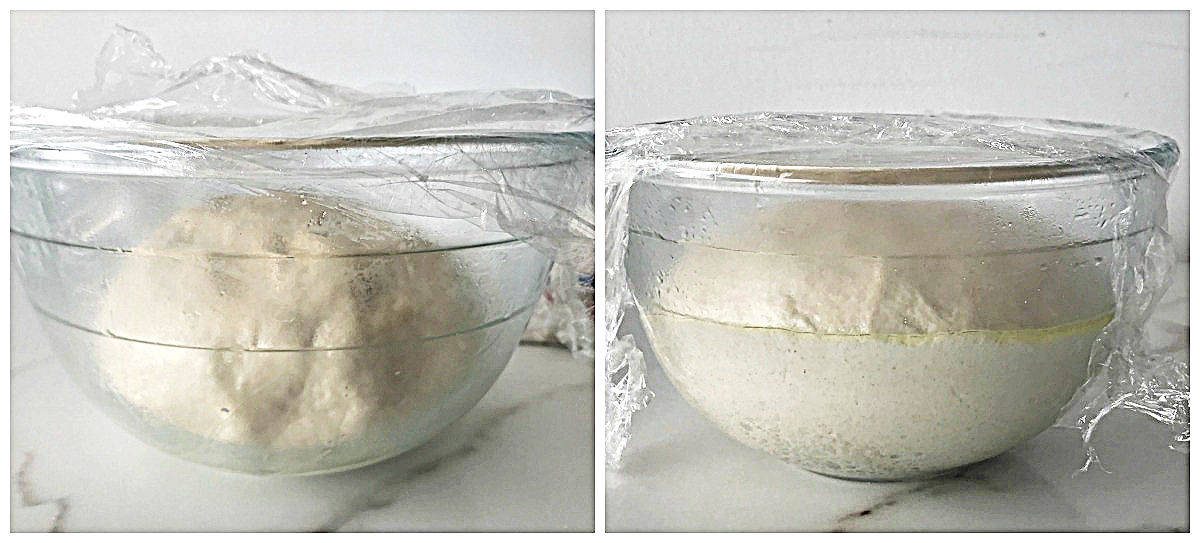
Forming the loaf
This part is not complicated because the dough is supple and great to work with. It can be shaped differently, and I like the batard, the French name for a plump and short baguette.
Important steps:
- Flattening the dough with your hands (image 9)
- Folding it like a cinnamon roll, and pinching after each fold (images 10 and 11)
- Pinching and sealing the whole bread (image 12) prevents it from' unfolding or unrolling' during baking.
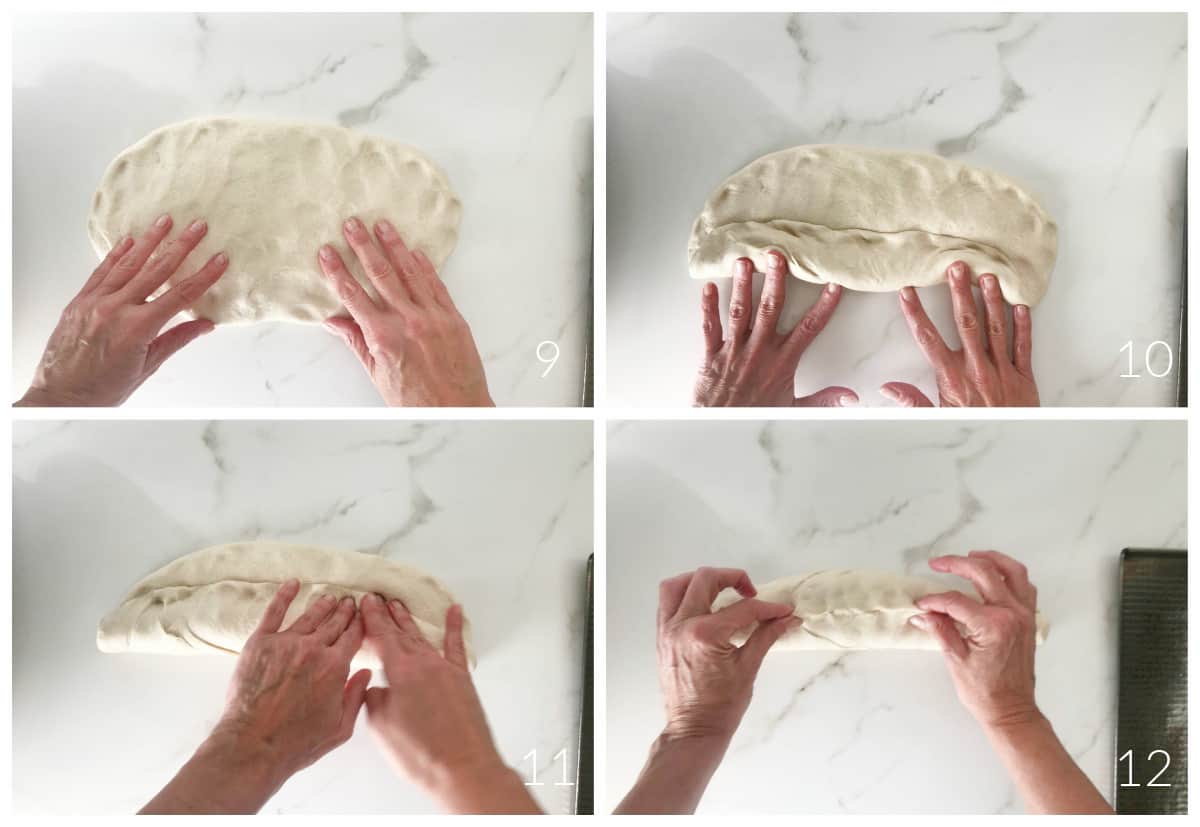
Second rising and scoring
- Second rise: once shaped and on the baking sheet (image 13), the bread needs a second rise. Cover it loosely with a clean kitchen towel and place it in a draft-free, warm place.
- Scoring the bread: these are the cuts or slits you make to the dough right before baking it. They will allow the bread to rise better as it has a place to unfold and grow. You can use a sharp knife (images 14 to 16) or a special tool called a lame. It is a razor blade on a stick. You can lightly aid yourself with your hand (image 15), but it's best to be decisive and go for the 45° angle cut.
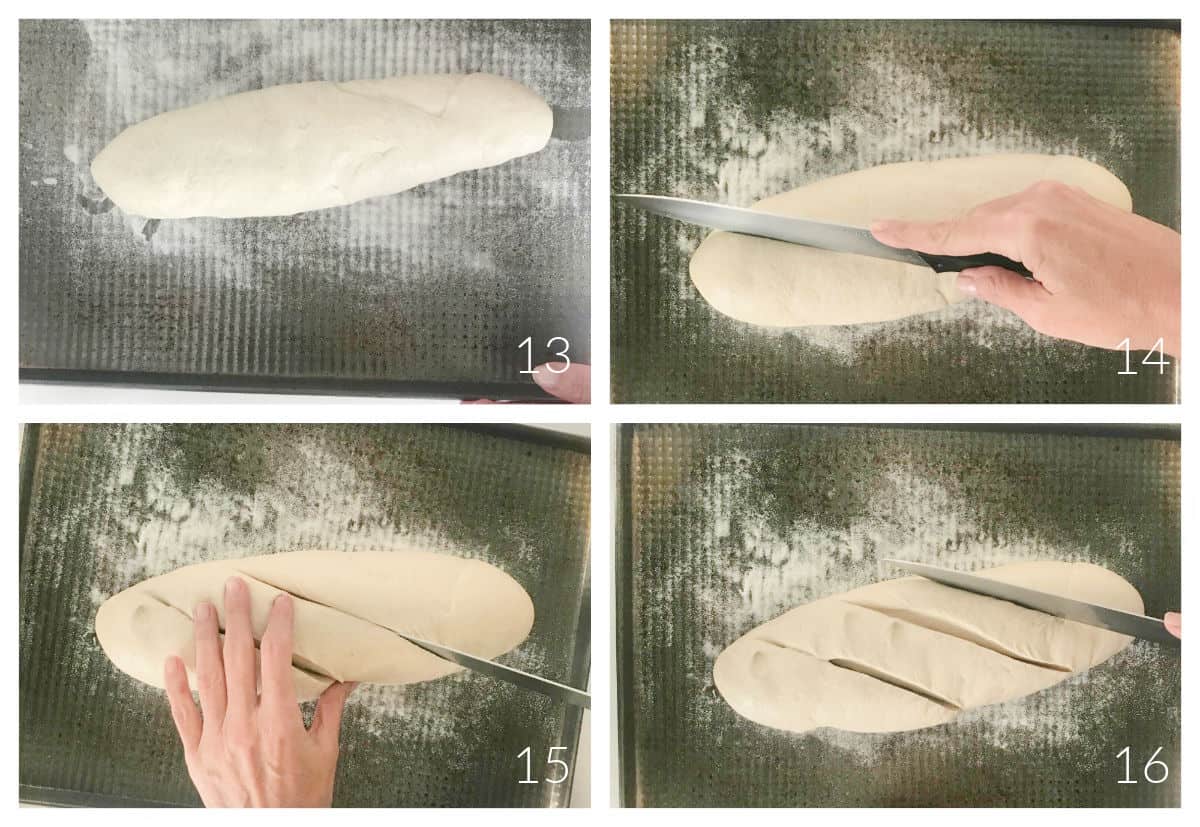
Baking
These loaves can have slight differences every time you bake them. If proofed correctly, the flavor will always be fantastic.
But sometimes the crust might be thinner or slightly thicker, the golden hue of the crumb might vary, and so on. Bread uses yeast and it's a living organism. So, it can be temperamental depending on the humidity, warmth of the environment, etc.
Tips to know if the bread is done:
- Size and shape: the loaf should have risen sufficiently and not appear dense. A good rise indicates that the yeast has done its job during the baking process.
- Color of the crust: the bread should be a deep golden brown.
- Hollow sound: lightly tap the bottom of the loaf with your knuckles or the back of a spoon. It should sound hollow or a spoon if it’s done. This is a traditional method that many bakers (including me) swear by, although it's less precise than using a thermometer.
- Internal temperature: some say it's the most reliable way to check if bread is fully baked. The internal temperature should be between 190°F and 210°F (88°C to 99°C).
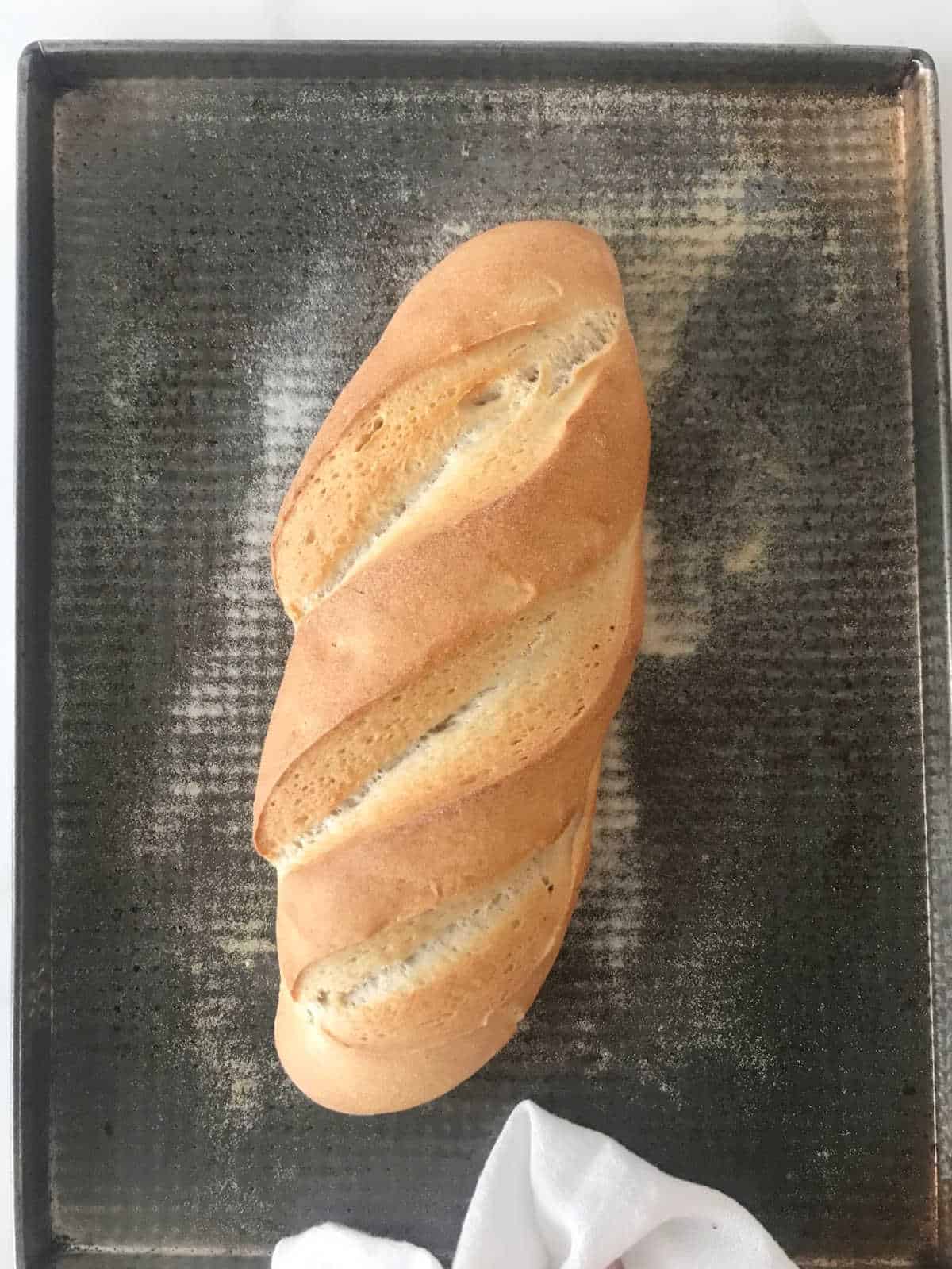
Kitchen Notes
- Organization: read the recipe first and ensure you have ingredients at the correct temperature, utensils and equipment needed, and enough workspace. This will make the process so much easier.
- Baking time: consider that all ovens and pans are different, even if they look similar. The baking time in my recipes is as accurate as possible, but it might take you more or less time. You can use a thermometer (like the OXO oven thermometer) to check that your oven is at the right temperature. I recommend tracking how your oven works and what tiny details you might need to adjust.
- Semolina: buy the superfine one. Though it should be labeled differently, semolina comes in different textures and coarseness. Couscous, for example, is also semolina.
- Bread flour: you can buy flour that is specially made for bread. It has more gluten than all-purpose. Gluten is the ingredient that develops during kneading, creating a structure that helps the bread grow. The bread will work with all-purpose flour (but not cake flour), but it's a good idea to use the right one, and you can buy bread flour online.
- Freezing: this is a wonderful bread to freeze in slices and have ready for toast or bruschettas. Slice it and wrap it in plastic or put it in a Ziploc bag. It will last for a month.
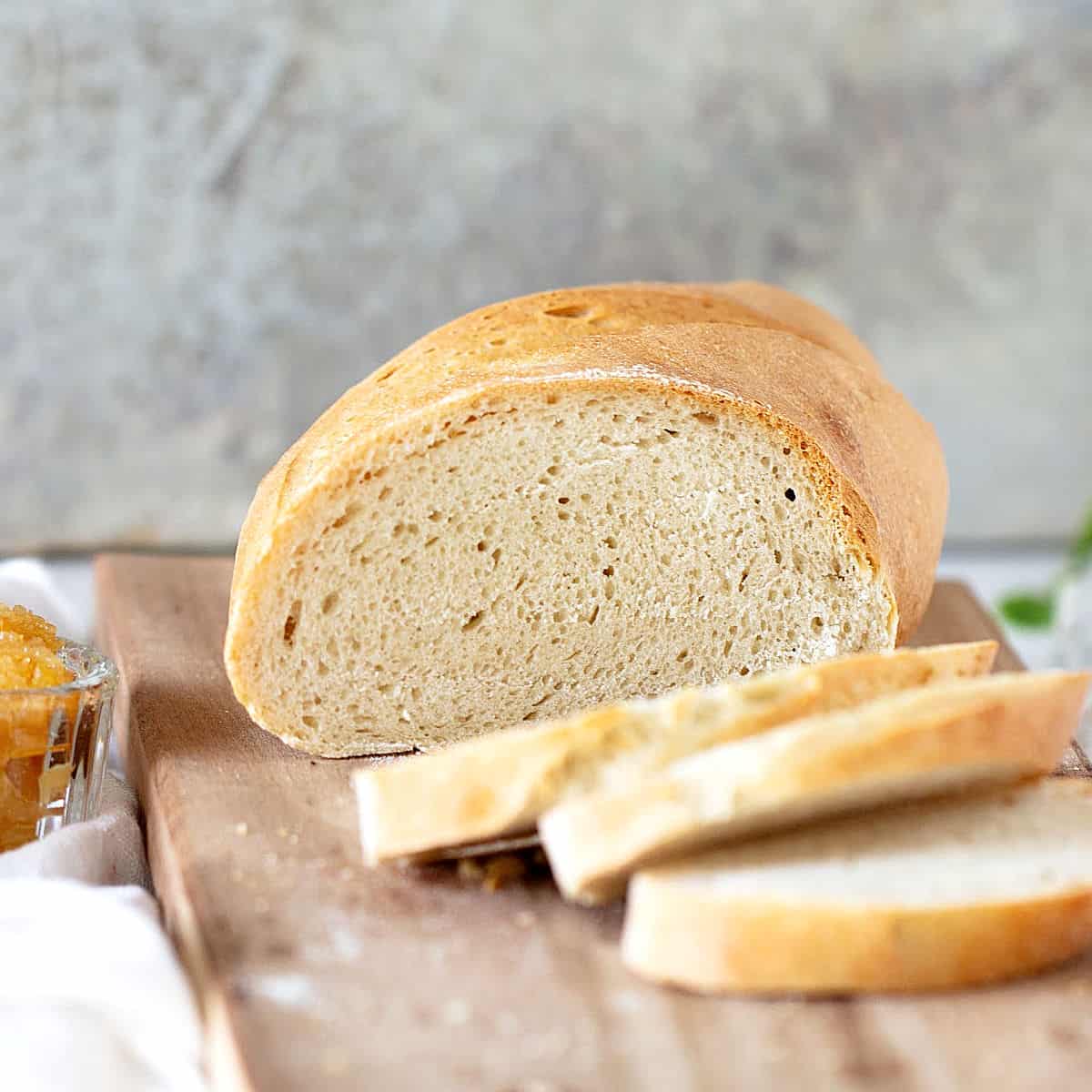
Related recipes you might like:
Before you go
If you made this recipe and loved it, you can comment below and leave a five-star ⭐️ review. Also, if you had issues, let me know so we can troubleshoot together.
You can also subscribe to our FREE email series 'Baking the Best' and our regular newsletter. Or follow and save my recipes on Pinterest.
As an Amazon Associate, I earn from qualifying purchases. Read my disclosure policy.
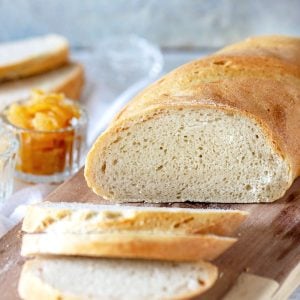
Best Semolina Bread
Ingredients
Sponge:
- 1 cup lukewarm water, tap is fine
- 1 teaspoon dry yeast, use 1 teaspoon active-dry yeast or ¾ teaspoon instant yeast, see Notes below
- 1 ½ cups all-purpose or bread flour, you can buy bread flour online
Dough:
- the sponge, above
- ½ cup all-purpose or bread flour, you can buy bread flour online
- ¾ cup semolina flour
- 1 to 2 teaspoons salt, If you normally don't use much salt go for the 1 teaspoon
- 2 tablespoons olive oil
Instructions
To make the sponge:
- Place 1 cup lukewarm water in a mixing bowl and whisk in 1 teaspoon dry yeast.
- Stir in 1 ½ cups all-purpose or bread flour, mix lightly and cover the bowl with plastic wrap.
- Set the sponge aside to rise at room temperature (draft-free and warm) until the sponge doubles, about 1 hour. I do this directly in the bowl of the standing mixer and then add the dough ingredients.
To make the bread:
- Have ready a baking sheet lightly dusted with semolina.
- Stir the sponge to deflate, and add ½ cup all-purpose or bread flour, ¾ cup semolina flour, 1 to 2 teaspoons salt, and 2 tablespoons olive oil.
- Adjust the bowl in your stand mixer and knead on low speed with the dough hook for about 5 minutes to form a smooth, elastic, and slightly sticky dough. Alternatively, turn the shaggy dough onto a lightly floured surface and knead by hand for about 6-7 minutes. See the post above for images and further details.
- Transfer the dough to an oiled bowl. Turn the dough, so all the sides are oiled. Cover the bowl with plastic wrap and let rise until doubled, about 1 hour.
- Turn the risen dough out on the floured work surface.
- Press with the palms of your hands to deflate.
- Shape the dough into an oval, folding as you would a cinnamon roll, pinching at the seams after each fold, and place tucked side down on the prepared pan and cover with oiled plastic wrap.
- Allow it to rise until doubled in volume, about 1 hour.
- About 20 minutes before baking, turn the oven to 400ºF (200ºC).
- Sesame seeds on top: this is optional. Lightly dampen the dough on top (carefully, as you don't want to tear or deflate it) and sprinkle the seeds.
- Hold a razor blade or sharp kitchen knife at about a 30º to 45° angle to the loaf, and slash 3 lines.
- Bake the loaf for about 35 minutes until well risen, golden brown, and the bottom sounds hollow when tapped. All ovens are different, so if 20 minutes into baking you feel the bread is darkening too much, turn it down to 375°F (190°C) for the rest of the baking.
- Remove from oven and cool on a wire rack until able to lift from the baking sheet with a spatula, and wait until completely cooled to cut.
Notes
Adapted from How to Bake by Nick Malgieri
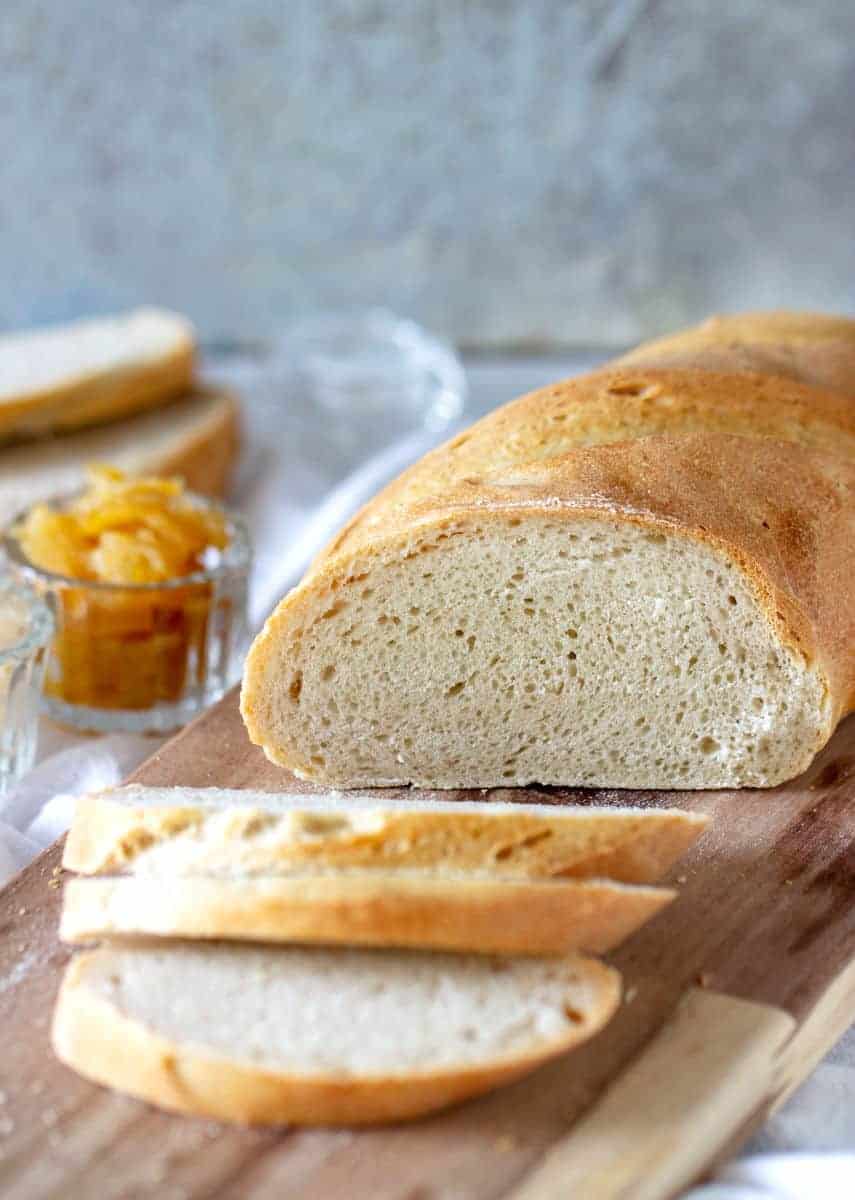

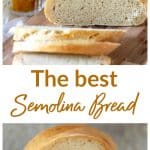
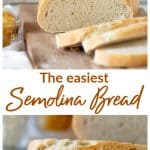
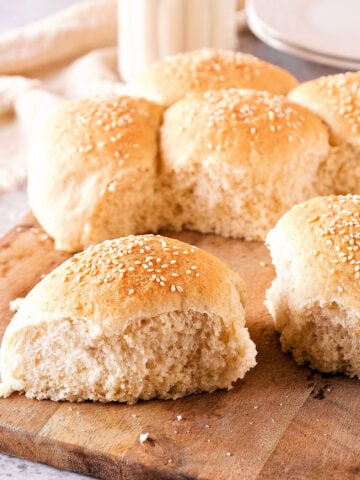
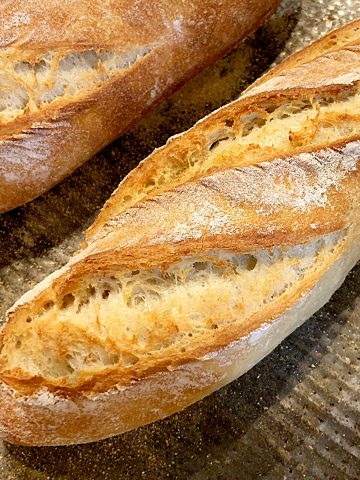
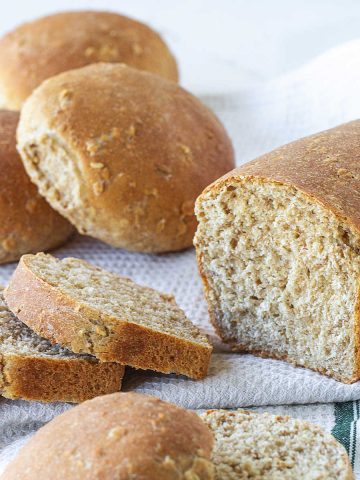
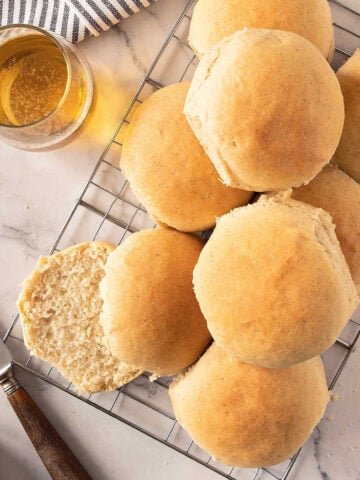
Frank Craft says
What are the quantities in brackets for ? It’s quite confusing
Paula Montenegro says
Hi Frank, I added the weight manually. But now it has a button you can toggle to change from US measurements to the metric system. So I deleted it. Thanks for the heads up!
Frank Craft says
Ok thanks
Patty says
Delicious recipe and easy to follow.
Joann says
Bread is so yummy, great recipe. I make 2 small loaves at least once a week, we keep 1 & give the other 1 away.
Kim says
I make ALOT of bread and this recipe is probably my favorite!! The crust is fantastic and it makes some of the best toast ever. This is going to be my new go to Italian bread recipe. Great job!
James Pavlock says
There doesn’t seem to be much of an airy crumb. The pics look pretty dense.
Anne Whipple says
I’ve tried this twice out of Nick’s book and both times ended up with a flat loaf (second time bought new yeast). The rise in the bowl worked great but formed loaf hardly rose while proofing, not at all in oven. Any tips? The dough did feel a bit dry … would adding water for a softer dough help? It tastes great, lovely crust but … dense.
Paula Montenegro says
Hi Anne! Some reasons might be that the water where the yeast was dissolved was too hot, the yeast was mixed with the salt from the beginning, the room was too cold so the dough never proofed as it should, the oven was low (sometimes the thermostat is off) and didn't have the initial oven spring it needs before forming the crust. Do any of these sound like something that might've happened?
A dry dough will not rise as much as you can certainly add a little extra water to make it more supple and soft.
Marilyn Cain says
Hi Paula. Can't wait to try this. Can i add rosemary and thyme to my dough?
Pauline says
I have made this bread twice, I thank you for sharing your well developed recipe of this semolina bread. I love the texture and everything about this bread. I have not and would not change anything in this recipe. It’s a keeper in my book.
Paula Montenegro says
Thanks so much Pauline!
Eric says
Can I still use semolina flour and bread flour in a 50/50 mixture?
Paula Montenegro says
Hi Eric! Semolina flour can be used in a larger percentage than the one in this recipe. I never tried it half and half but you shouldn't have issues.
Lidia says
Hi Paula! Great recipe! Can I leave the bread covered overnight at step 11 and put in the oven in the morning? If yes, does it need to stay in the fridge overnight or is it ok to leave it on the kitchen counter covered with the oiled cling film? - Lidia
Paula Montenegro says
Hi Lidia! If you leave it out overnight, it will almost certainly overproof (rise too much and then collapse) and lose strength to rise in the oven. I suggest putting it in the refrigerator after the bread is formed but not scored and taking it out the next day, scoring and baking it. Hope this helps.
Raj Sen says
Thank you for your excellent recipe!
Ken says
This was my second try at a semolina recipe. The first was too heavy but yours is just right
Paula Montenegro says
Happy to know it worked Ken! Have a great weekend.
Russ says
I am 82 and never baked baked before. I followed step by step no substitutions I cant believe I am eating semolina Italian bread like I had growing up in New Jersey. I live in Florida now and the bread is not as good as this. Thank you for a great recipe.
Paula Montenegro says
Hi Russ, I'm so happy you loved it! Have a great week.
Joseph Segari says
Made it today for first time.Fantastic
Paula Montenegro says
Happy to know that Joseph!
Raj says
Hi Paula, I am a beginner!!
Please help! Do I bake in a silicone or metal baking or glass tray/dish?
Thank you!
Raj - Perth WA
Paula Montenegro says
Hi Raj! I always use metal pans dusted with semolina, cornmeal, oats, or whatever the recipe suggests. It works very well when baking bread. So great that you're starting to bake bread! Happy baking.
Raj says
It came out perfect on a baking tray! I am making the second one for my daughter!!!! Thank you
Paula Montenegro says
Glad it worked Raj! Happy baking.
Caro says
A fantastic recipe, thank you! Worked like a dream. A beautiful loaf!
Paula Montenegro says
Happy to know that Caro! Have a great week.
Karen5 says
Made this exactly as written with 2 tsp salt. It’s an excellent recipe; ideal for beginners! Woke up to half the large loaf gone and red pepper flakes, olive oil and parmesan shavings across the counter, so the 13 y o boy approves as well. Made excellent toast that still holds moisture-- VERY nice!!
Next time, I will sub the semolina for the 1/2 cup of bread flour in the “dough” part of the recipe (and try both 3/4c semolina plus 1/2c semolina) and make two tight longer rolls because the rise is just gorgeous!! I would encourage anyone to stretch and fold during the rises. I’m also curious to add a steam pan of water in the oven and see what it does. Maybe I’ll cook them separately-- one with, one w/o water.
Thank you!!
This is a nice technique bread.
Paula Montenegro says
Thanks for the input Karen and so happy you all liked it! This bread is amazing and I'm sure it can accommodate to several ratios of semolina flour. I do bake with steam sometimes and the crust tends to be snappier. Happy weekend baking.
Kathleen says
I live in high altitude, 5200 feet above sea level. Are there any adjustments to the recipe to account for the thinner air?
Paula Montenegro says
Hi Kathleen, I never baked at high altitude so I can't give you an answer from my experience. I think your best bet is to google it. There is a nice chart for high-altitude baking on the King Arthur Baking page.
Raffaela says
Hello could I bake this in a cloche? I could make a round loaf and let it rise in there for the last proof. I love crusty Italian bread!
Paula Montenegro says
Hi Raffaela! I don't see why not. I don't have a cloche, but if you do and know how to use it, you should be fine. This is a simple bread, so there should be no issues.
Charleen says
Hi Paula, I live in South Africa & our Cup sizes are 250ml. I know in the USA it is 240ml. In this recipe 1 Cup Water is required. How much do i use?
Thank you
Paula Montenegro says
Hi Charleen! My USA cups weigh between 235g and 238g with water. There is usually a few grams of difference depending on what you read and the scale you use as they might not all be calibrated perfectly.
So take 240g as the standard, it's what I do, what usually appears on google, it's a round number and a few grams won't make a difference in the types of recipes I post. Hope this helps. Happy baking!
Charleen says
Thank you so much for your prompt reply. I went with the 240g.
Now just waiting for the sponge.
Will let you know how it turns out.
Leah says
Can the dough be formed and the frozen to bake at a later date ?
Paula Montenegro says
Hi Leah, I never tried it with this bread recipe, but I have frozen proofed and formed loaves before. Let them rise as directed and freeze the just formed loaves. Then let them come to room temperature and rise again for the last time before baking them.